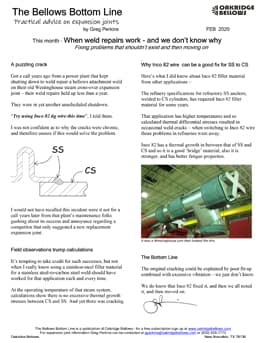When Weld Repairs Work – And We Don’t Know Why

This month – When weld repairs work – and we don’t know why
Fixing problems that shouldn’t exist and then moving on
A puzzling crack
Got a call years ago from a power plant that kept shutting down to weld repair a bellows attachment weld on their old Westinghouse steam cross-over expansion joint – their weld repairs held up less than a year. They were in yet another unscheduled shutdown. “Try using Inco 82 tig wire this time”, I told them. I was not confident as to why the cracks were chronic, and therefore unsure if this would solve the problem. I would not have recalled this incident were it not for a call years later from that plant’s maintenance folks gushing about its success and annoyance regarding a competitor that only suggested a new replacement expansion joint.
Field observations trump calculations
It’s tempting to take credit for such successes, but not when I really know using a stainless-steel filler material for a stainless steel-to-carbon steel weld should have worked for that application each and every time. At the operating temperature of that steam system, calculations show there is no excessive thermal growth stresses between CS and SS. And yet there was cracking.
.
Why Inco 82 wire can be a good fix for SS to CS
Here’s what I did know about Inco 82 filler material from other applications – The refinery specifications for refractory SS anchors, welded to CS cylinders, has required Inco 82 filler material for some years. That application has higher temperatures and so calculated thermal differential stresses resulted in occasional weld cracks – when switching to Inco 82 wire those problems in refineries went away.
Inco 82 has a thermal growth in between that of SS and CS and so it is a good ‘bridge’ material, also it is stronger, and has better fatigue properties.
It was a Westinghouse unit that looked like this
The Bottom Line
The original cracking could be explained by poor fit-up combined with excessive vibration – we just don’t know. We do know that Inco 82 fixed it, and then we all noted it, and then moved on.


